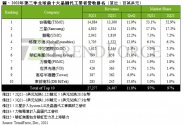Changguangchen Core successfully passed the acceptance of major nuclear high-tech projects
Nuclear high base of major projects is one of the "Long-term Scientific and Technological Development Plan (2006-2020)" determined by national sixteen major science and technology, its purpose in
the nuclear heart of electronic devices,
high- end general chips and
based foundation software, catch up with international technology and the rapid development of the industry. In October 2021, Changguangchen Core's major nuclear-high-base special project "8K ultra-high-definition image sensor chip and system application" successfully completed the acceptance work.
Changguang Chenxin takes the lead in the major special project "8K ultra-high-definition image sensor chip and system application" of Nuclear High-tech, and cooperates with Zhejiang Huarui Technology Co., Ltd., Shenzhen DJI Innovation Technology Co., Ltd. and Shenzhen DJI Piovan. Jointly undertaken by Technology Co., Ltd., the project was approved by the Ministry of Industry and Information Technology in 2019. This project aims to develop 8K ultra-high-definition CMOS image sensor chips and camera systems with independent intellectual property rights, and break the situation that my country's ultra-high-definition imaging chips and systems have long been dependent on foreign imports and their development is severely limited. During the project implementation period, with the support of the Ministry of Industry and Information Technology and various local governments, the four development units worked together to finally complete the development of two 8K ultra-high-definition CMOS image sensors. At the same time, based on the two image sensors, the national production and independent The development of a controllable and competitive 8K ultra-high-definition camcorder. The smooth acceptance of this project will surely bring new changes to my country's ultra-high-definition industry, and will also drive my country's ultra-high-definition display industry and 5G ultra-high-speed transmission The rapid upgrading of other industries.
Changguangchenxin is a company specializing in the design of high-end, high-performance CMOS image sensors. Its core applications include high-end scientific imaging and industrial vision imaging. The CMOS image sensor chip required in the 4K/8K ultra-high-definition camera system has high performance requirements, such as ultra-low readout noise, ultra-high dynamic range, and high frame rate. It is highly compatible with the technical route and capabilities of Changguangchen Core. Therefore, Changguangchen Core also regards professional photography as the company's next important market direction. With the support of this project, Changguangchen Core has completed the development of an 8K full-frame, back-illuminated, stacked CMOS image sensor with a resolution of 49 million pixels, a 4.3-micron pixel design, and readout noise. Less than 2e-, the single-frame dynamic range reaches 87dB; the chip uses the most advanced back-illuminated, stacking technology, under 16bit ADC output, the frame rate is up to 120fps in 8K mode, and up to 240fps in 4K mode. The chip is extremely advanced in terms of process platform selection and performance indicators, and it will also speed up the pace of my country's ultra-high-definition camera system to catch up with the international leading level.
With the support of the special project, Changguangchen Core has broken through a number of key technologies and stacking processes, and pressed the fast forward button for the company in the development of ultra-high-definition 8K/4K CMOS image sensors, forming the GCINE series for the radio and television field Chemical products to meet the needs of many industries such as 8K broadcast television, SLR cameras, drones, and high-end 8K video surveillance, and accelerate the pace of upgrading my country’s ultra-high-definition industry.
Figure 1: The physical 8K CMOS chip

